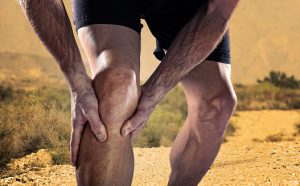
The following are probably some of the most common and well-known exercises. They are easy to perform and suitable for any fitness level. Try incorporating these into your daily routine, but be gentle at first and don’t go overboard. After all, you want to help your joints rather than causing them extra stress.
Squats
A simple squat engages the same muscles that are used when we get up from a chair. Standing with your feet hip-width apart, bend your knees, lowering yourself into a deep squat. Keep your knees over your toes and make sure to use your abs too. If you feel like squatting is too hard on your knees, try putting more weight on your heels. Ten squats a day is a good start. Try holding the squat for 5 to 10 seconds for added benefit. Don’t bend your knees past 90 degrees to avoid added stress to the joints.
Lunges
Lunges keep your legs and glutes toned and engage your ab muscles too. Take a step forward with your right leg. Lower your left knee toward the floor while bending your right knee at a 90-degree angle. Hold the lunge. To come out, push off the floor with your left leg. Repeat 12 times on each side.
Point and flex
This may remind you of a dancer’s warm up, pointing and flexing the toes. Place a stretch band over your foot and pull for resistance. Slowly point and flex your foot. At first, it may seem that only your toes are involved, but try to make an effort to engage your whole foot. Repeat 15–20 times per foot. (Note: even if you don’t have a band, you can start off by simply pointing and flexing your foot without any accessories.)
Arm raises
As mentioned, it’s essential to work out the entire body, so once you’re done with the legs and ankles, move on to your arms. Standing with your feet hip-width apart, bend your knees slightly and keep your palms faced down. Raise your arms in front of you, then bring them overhead. If there’s too much pressure on your shoulders, try rotating your arms. Do three sessions of 12 arm lifts.
Lateral arm raises
This is very similar to the previous exercise, but here you’re bringing your arms out to the side. To avoid pressure in the shoulders, don’t raise your arms too high. Once your arms are at the shoulder level, bend your elbows and reach up to the ceiling. Do three sessions of 12 arm lifts.
Don’t forget to wrap up your session with a good stretch. This will help prevent injuries and make you feel good after the hard work that you’ve done. Pat yourself on the shoulder for the effort (and while you’re at it, check your joint pain—it should feel better by now).
Related: How aging affects muscles, joints, and bone health